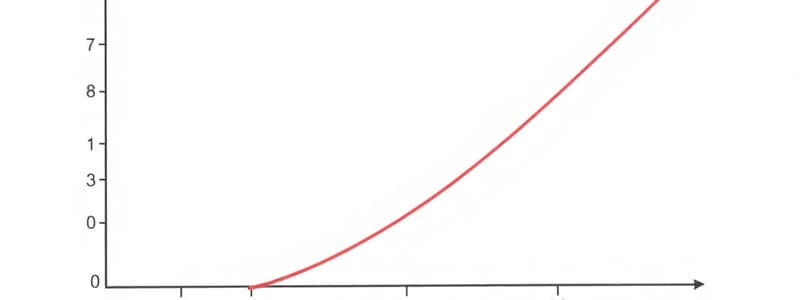Podcast
Questions and Answers
What shape do the indifference curves take for perfect substitutes?
What shape do the indifference curves take for perfect substitutes?
- Straight lines (correct)
- Diagonal lines
- Circular lines
- Curved lines
What does an indifference curve shaped as a right angle indicate about the goods?
What does an indifference curve shaped as a right angle indicate about the goods?
- They are perfect complements (correct)
- They are perfect substitutes
- They are normal goods
- They are inferior goods
In the case of perfect substitutes, how does a consumer perceive the trade-off between two goods?
In the case of perfect substitutes, how does a consumer perceive the trade-off between two goods?
- The consumer will only consume one type of good
- The consumer is indifferent to the quantity of each good (correct)
- The consumer prefers one good over the other
- The consumer values both goods equally only if consumed together
What happens to the consumer's satisfaction if they obtain an additional left shoe without a matching right shoe?
What happens to the consumer's satisfaction if they obtain an additional left shoe without a matching right shoe?
How can one describe the relationship between the quantities of left shoes and right shoes for a consumer who views them as perfect complements?
How can one describe the relationship between the quantities of left shoes and right shoes for a consumer who views them as perfect complements?
What characterizes the marginal rate of substitution (MRS) for perfect complements?
What characterizes the marginal rate of substitution (MRS) for perfect complements?
What is a neutral good in the context of consumer preferences?
What is a neutral good in the context of consumer preferences?
In which direction does increasing preference for a consumer's bundles of goods move on the graph?
In which direction does increasing preference for a consumer's bundles of goods move on the graph?
What is the primary goal of the theory of consumer behaviour?
What is the primary goal of the theory of consumer behaviour?
What is assumed about consumers in traditional consumer behaviour theory?
What is assumed about consumers in traditional consumer behaviour theory?
Which of the following accurately describes a consumption bundle?
Which of the following accurately describes a consumption bundle?
How is the consumer's choice behavior depicted graphically in the theory of consumer behaviour?
How is the consumer's choice behavior depicted graphically in the theory of consumer behaviour?
What do we assume about the number of different goods in the consumer behaviour theory?
What do we assume about the number of different goods in the consumer behaviour theory?
What does the convexity of a consumption set imply?
What does the convexity of a consumption set imply?
What role does a household play in consumer behaviour when purchasing goods and services?
What role does a household play in consumer behaviour when purchasing goods and services?
How do changes in income and prices affect consumer behavior according to the theory?
How do changes in income and prices affect consumer behavior according to the theory?
What happens to the budget line when both prices of Good 1 and Good 2 increase simultaneously by a constant factor?
What happens to the budget line when both prices of Good 1 and Good 2 increase simultaneously by a constant factor?
If the prices of both goods double, how does this affect the intercepts of the budget line?
If the prices of both goods double, how does this affect the intercepts of the budget line?
When the price of Good 2 increases more than the price of Good 1, what effect does this have on the slope of the budget line?
When the price of Good 2 increases more than the price of Good 1, what effect does this have on the slope of the budget line?
What effect does an increase in the price of Good 1 have on the budget line?
What effect does an increase in the price of Good 1 have on the budget line?
How does a quantity tax affect the price of a good in terms of the consumer's budget line?
How does a quantity tax affect the price of a good in terms of the consumer's budget line?
How does a decrease in the price of Good 2 affect the vertical intercept of the budget line?
How does a decrease in the price of Good 2 affect the vertical intercept of the budget line?
What happens to the slope of the budget line when the price of Good 2 decreases?
What happens to the slope of the budget line when the price of Good 2 decreases?
What implication does an increase in both prices and a simultaneous decrease in income have on the budget line?
What implication does an increase in both prices and a simultaneous decrease in income have on the budget line?
If the price of Good 2 increases, what is the expected change in the budget line?
If the price of Good 2 increases, what is the expected change in the budget line?
If both goods are subjected to a price increase by a constant amount, what is the mathematical representation of the new budget constraint?
If both goods are subjected to a price increase by a constant amount, what is the mathematical representation of the new budget constraint?
In which situation does the budget line remain unchanged?
In which situation does the budget line remain unchanged?
What does the maximum amount of Good 1 purchased represent at the higher price of Good 1?
What does the maximum amount of Good 1 purchased represent at the higher price of Good 1?
When the price of Good 2 is reduced, which of the following does NOT change?
When the price of Good 2 is reduced, which of the following does NOT change?
If the price ratio p1/p2 increases, what can be inferred about the budget line?
If the price ratio p1/p2 increases, what can be inferred about the budget line?
What is the graphical representation of an increase in the price of Good 2?
What is the graphical representation of an increase in the price of Good 2?
If the price of Good 1 is unchanged, what primarily affects the budget line when Good 2's price changes?
If the price of Good 1 is unchanged, what primarily affects the budget line when Good 2's price changes?
What does the theory of revealed preference base its inference of consumer preferences on?
What does the theory of revealed preference base its inference of consumer preferences on?
Which statement correctly reflects the concept of consistency in revealed preference?
Which statement correctly reflects the concept of consistency in revealed preference?
If a consumer chooses basket A over basket B and both baskets cost the same, what can we conclude?
If a consumer chooses basket A over basket B and both baskets cost the same, what can we conclude?
What assumption is NOT part of the revealed preference axiom?
What assumption is NOT part of the revealed preference axiom?
Which of the following describes transitivity in consumer preferences?
Which of the following describes transitivity in consumer preferences?
In terms of cardinal utility, how is a higher utility assigned?
In terms of cardinal utility, how is a higher utility assigned?
How can the revealed preference theory be illustrated in a marketplace?
How can the revealed preference theory be illustrated in a marketplace?
What is an implication of a consumer choosing a more expensive basket when a cheaper option is available?
What is an implication of a consumer choosing a more expensive basket when a cheaper option is available?
What is the marginal rate of substitution (MRS) of good 1 for good 2 calculated as?
What is the marginal rate of substitution (MRS) of good 1 for good 2 calculated as?
Which transformation is not considered a monotonic transformation?
Which transformation is not considered a monotonic transformation?
What does the marginal utility of a good indicate?
What does the marginal utility of a good indicate?
If the utility function is given as $u(x_1, x_2) = x_1 x_2$, what does this indicate about its indifference curves?
If the utility function is given as $u(x_1, x_2) = x_1 x_2$, what does this indicate about its indifference curves?
Which utility function is a monotonic transformation of $u(x_1, x_2) = x_1 x_2$?
Which utility function is a monotonic transformation of $u(x_1, x_2) = x_1 x_2$?
How is the marginal utility of good 1 calculated?
How is the marginal utility of good 1 calculated?
Which statement accurately describes the property of monotonic transformations?
Which statement accurately describes the property of monotonic transformations?
If a consumer is willing to give up 2 units of good 2 for 1 additional unit of good 1, what is the MRS of good 1 for good 2?
If a consumer is willing to give up 2 units of good 2 for 1 additional unit of good 1, what is the MRS of good 1 for good 2?
Flashcards
Consumer Behavior
Consumer Behavior
How consumers use their income to buy goods to get the most satisfaction
Consumer
Consumer
Individual or household using a good or service; rational, making utility-maximizing decisions with limited income and information
Consumption Bundle
Consumption Bundle
Specific combination of goods a consumer wants to consume; often depicted with x1, x2 for two goods
Utility Maximization
Utility Maximization
Signup and view all the flashcards
Market Demand
Market Demand
Signup and view all the flashcards
Consumption Set
Consumption Set
Signup and view all the flashcards
Goods
Goods
Signup and view all the flashcards
Rational Consumer
Rational Consumer
Signup and view all the flashcards
Perfect Substitutes
Perfect Substitutes
Signup and view all the flashcards
Indifference Curve (Perfect Substitutes)
Indifference Curve (Perfect Substitutes)
Signup and view all the flashcards
Perfect Complements
Perfect Complements
Signup and view all the flashcards
Indifference Curve (Perfect Complements)
Indifference Curve (Perfect Complements)
Signup and view all the flashcards
Marginal Rate of Substitution (MRS)
Marginal Rate of Substitution (MRS)
Signup and view all the flashcards
Neutral Good
Neutral Good
Signup and view all the flashcards
Preferences shape indifference curves
Preferences shape indifference curves
Signup and view all the flashcards
Fixed Proportions
Fixed Proportions
Signup and view all the flashcards
Impact of Good 1 Price Increase on Budget Line
Impact of Good 1 Price Increase on Budget Line
Signup and view all the flashcards
Impact of Good 2 Price Decrease on Budget Line
Impact of Good 2 Price Decrease on Budget Line
Signup and view all the flashcards
Horizontal Intercept of Budget Line
Horizontal Intercept of Budget Line
Signup and view all the flashcards
Vertical Intercept of Budget Line
Vertical Intercept of Budget Line
Signup and view all the flashcards
Budget Line Slope
Budget Line Slope
Signup and view all the flashcards
Impact of Good 2 Price Increase on Budget Line
Impact of Good 2 Price Increase on Budget Line
Signup and view all the flashcards
Budget Line Rotation
Budget Line Rotation
Signup and view all the flashcards
Consumer's Income
Consumer's Income
Signup and view all the flashcards
Budget Line Shift: Price Increase
Budget Line Shift: Price Increase
Signup and view all the flashcards
Budget Line Shift: Price Decrease
Budget Line Shift: Price Decrease
Signup and view all the flashcards
Price Changes and Budget Line Slope
Price Changes and Budget Line Slope
Signup and view all the flashcards
Quantity Tax Impact
Quantity Tax Impact
Signup and view all the flashcards
Budget Line Unchanged
Budget Line Unchanged
Signup and view all the flashcards
Budget Line Shift: Income Decrease
Budget Line Shift: Income Decrease
Signup and view all the flashcards
Budget Line Shift: Price Increase (Different Rates)
Budget Line Shift: Price Increase (Different Rates)
Signup and view all the flashcards
Budget Line Shift: Price Decrease (Different Rates)
Budget Line Shift: Price Decrease (Different Rates)
Signup and view all the flashcards
Revealed Preference
Revealed Preference
Signup and view all the flashcards
Rationality Assumption
Rationality Assumption
Signup and view all the flashcards
Transitivity
Transitivity
Signup and view all the flashcards
Cardinal Utility
Cardinal Utility
Signup and view all the flashcards
Ordinal Utility
Ordinal Utility
Signup and view all the flashcards
Consistency Assumption
Consistency Assumption
Signup and view all the flashcards
Revealed Preference Axiom
Revealed Preference Axiom
Signup and view all the flashcards
Marginal Utility (MU)
Marginal Utility (MU)
Signup and view all the flashcards
How to calculate MRS?
How to calculate MRS?
Signup and view all the flashcards
How to calculate MU?
How to calculate MU?
Signup and view all the flashcards
Monotonic Transformation
Monotonic Transformation
Signup and view all the flashcards
Utility Function
Utility Function
Signup and view all the flashcards
Indifference Curve
Indifference Curve
Signup and view all the flashcards
How to draw indifference curves from a utility function?
How to draw indifference curves from a utility function?
Signup and view all the flashcards
Study Notes
Introduction to Study Notes
- These notes will provide a framework for studying various subjects.
- Each section covers key concepts, definitions, and examples.
Studying That Suits You
Use AI to generate personalized quizzes and flashcards to suit your learning preferences.




